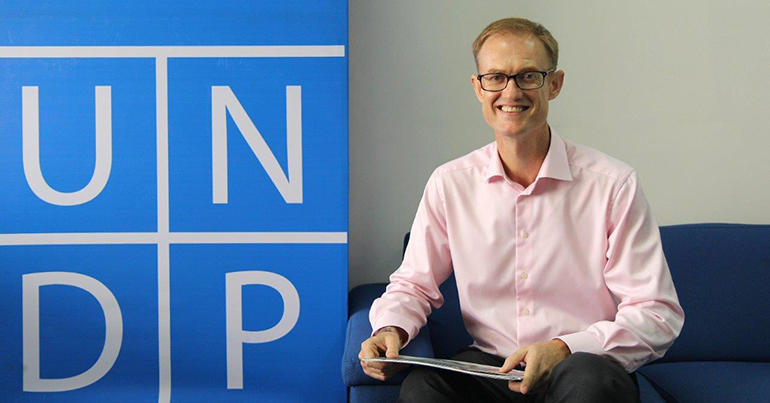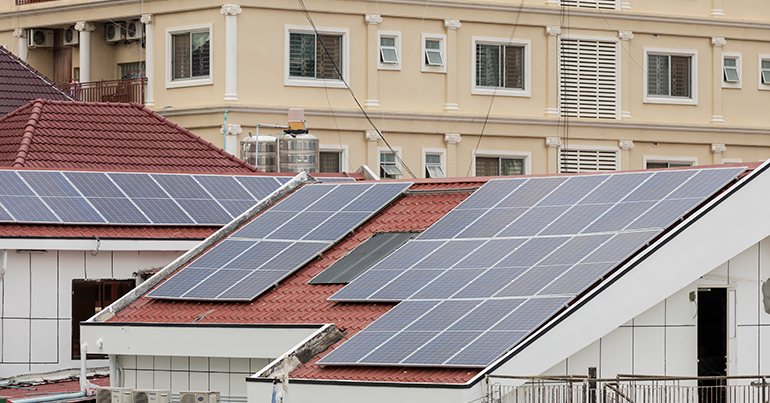Nick Beresford, country director of the United Nations Development Programme (UNDP) in Cambodia, discusses the state of Cambodia’s energy sector, the hope of solar, and bringing electricity to everyone

Where does Cambodia’s electricity come from?
It has a very large hydro sector – 46 % – so that’s the single largest part of the energy mix. It then has another 33% coming from traditional coal-fired power stations, and a further 13% is imported. The biggest import share is Vietnam, followed by Thailand, and a small amount coming from Laos. The remaining 8% is a mixture of oil and some additional fuels.
Where is the imported electricity coming from?
It’s a bit of an odd situation that Cambodia does import so much, and it’s good to see that Electricité du Cambodge (EDC) is reducing that by bringing up production here – now Cambodia is looking at exporting electricity to Thailand. There is a lot of scope there to have a more optimal mix of energy, and indeed, where energy security issues can be tackled and energy trading might be better. [Cambodia is] importing electricity from Vietnam, but Vietnam’s labour costs and land costs are much higher than Cambodia’s. So we can see potential for Cambodia to produce more of its own energy and indeed, get into energy exportation itself.
What about renewable energy?
The reason I didn’t mention renewables is because they [make up] less than 1% of the energy mix; it’s so tiny it’s almost non-existent. There is no solar effectively. There are one or two solar pilots that we’ve seen, such as the Sunseap solar facility close to Bavet and a bunch of commercial buildings with rooftop solar – so there are some good footsteps towards it, and [there has been] encouragement from EDC, the Ministry of Mines and Energy and from the Ministry of Environment – but it’s at a very low state at the moment.
On that subject, how open has the government been to investing more in renewables?
To be fair to them they are certainly open to the idea, and if you compare the atmosphere to, say, five years ago, it has come quite a way to understanding it.
Also, to be fair to those civil servants and officials, it’s because it is such a fast-moving subject. It’s a different world from five years ago, certainly from ten years ago. It’s a very complex issue as well because it involves issues of how you manage a grid, of the technology in the actual production of the electricity itself, and also innovation in the financing options.
[InspireAsean2018]
If you take those three things together then there are a lot of moving parts to this, but I think now we are at a point where the government is keenly aware that there is an opportunity here – that there is scope for what they would call a win-win. You can get your high growth, you can get your contribution to energy costs, you can keep those prices coming down and you can start to move more in environmentally improved ways so that you… don’t lock yourself into a brown energy spiral, which is easy to do, but very dangerous and extremely costly later on.
For example, we did some work with the Ministry of Economy and Finance to find out what the climate change risks coming through the system are. We concluded that we could lose up to 10% of the country’s gross domestic product (GDP) by 2050 through climate change effects, if we don’t successfully adapt to mitigate. These climatic and environmental factors are real and they need to be taken into the consideration of the choices that we make in the energy mix.

Cambodia’s electricity demand is increasing…
The thing about electricity demand is that it is very difficult to forecast because it’s a little bit like an iceberg where you see the top of it but you don’t really see the bottom of it. Why, because people look at the levelised cost of electricity in this country and they think about setting up a factory or a service centre but they decide against it. Because they say that even if the cost of electricity comes down by 5% or 8%, it’s still really expensive. So it is very difficult to measure that loss of foreign direct investment because electricity costs are only revealed when the price of the fuel changes.
Although there are subsidies for very micro uses of electricity within Cambodia, particularly in Phnom Penh… the electricity price costs here are punishing. There are all sorts of benefits, I think, in terms of industrial, in terms of growth, social cohesion, equity, and in leaving no one behind so that electricity really is genuinely more affordable for all people.
To be fair to EDC, the government is very aware of this and has been successful in bringing the cost down, so it’s not like they don’t know or care or they are not aware.
The other thing people keep saying is “grid stability, grid stability, we can’t put in solar”. Grid stability is a factor on a traditional centralised grid such as the one in Cambodia. Once you get to maybe 20% solar, then yeah, you would maybe need to start thinking about how you would manage the grid. But at less than 1% solar, there is no issue of stability. It’s fine. It needs to be thought of in the long-term planning, but in the [near term] the road is clear in that respect.
The government is genuinely motivated by wanting to keep power prices falling and really seize economic growth that is inclusive
What about off grid communities?
Off grid is tremendously important, I think primarily just from the point of view of social equity – often these are the poorest communities. I think that off grid solutions five to ten years ago were quite the poor-persons option, they really weren’t very good. They are getting better and better all the time now. We’re seeing both innovation in the way that electricity is generated and also in the way that it is managed, for example with microgrids – although such systems at the moment are technically illegal because you have to go through EDC.
There are clear benefits [to] accelerating off grid, because EDC is not going to get to [many regions in Cambodia] for a long time. So I think even something as simple as a plan for where the grid is going to go and when would be hugely beneficial. Then private investors would be able to say, “okay, I’ve got at least 12 years to make my money back if I start to work with these communities and these villages”.
[manual_related_posts]
Sometimes I think NGOs, the UN and others have to be a little careful not to randomly assign grant funding that gives away solar systems and then kills the market, then the project comes to an end and the NGO disappears. And what is the community left with? It is left with a broken, non-functioning solar system, without a proper backup, and the private company has already gone bust because it couldn’t compete against zero cost.
So I think we have to be a bit careful about how we, as development partners, work with government communities, but also make sure that we can allow the private sector to come in and make money. There could be some very nice solutions there for the off grid.
What we would like to do is to stand between the government, the private sector and between the communities and then try to make sure we get the best outcome for those who have been denied access to energy. And [this is] something the government understands and is very supportive of.
Are you optimistic about the future of renewable energy in Cambodia?
Yes, I’m very optimistic because I see lots of opportunities and I also see a government that is cautiously thinking through the different options, but is genuinely motivated to find options that bring all Cambodians into some form of power – preferably on the grid, but if not, high-quality off grid solutions. The government is genuinely motivated by wanting to keep power prices falling and really seize economic growth that is inclusive.

